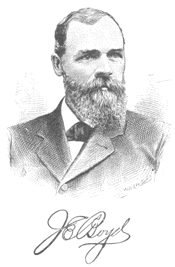"Monowi" is the beautiful Indian word for flower, more specifically a flower with milky juice that we know as snow-on-the-mountain.
For many years there was an uneasy truce between the settlers and the Indians. Often the Indians would appear at the door, begging for food or water. When things were "missing," settlers invariably blamed the Indians. On the other hand, settlers would occasionally graze their cattle on Indian land when pastures south of the river became short, which angered the Indians greatly.
A story is told of two boys who herded cattle to the grassland across the river one day. Seeing the "invasion," the Indians took them all to the Rosebud Agency. When the boys failed to return home that night, their father immediately rode to the agency. He was relieved to find them alive and unharmed, but was obliged to pay a ransom to have the boys and the cattle released.
In 1889 a treaty was proposed to deed a portion of the Indian Reservation to the United States government, then to the State of Nebraska. President Harrison proclaimed the territory "open for settlement" in February 1890. The earliest settler was said to be Emil Schindler.
There was no great uproar in connection with this settlement. Nothing like the "land rush" in Oklahoma or when the Rosebud was opened. The fact that the area was rather small, plus its location between the "Big Muddy" and the Sandhills, made it less desirable and quite
isolated.
The first year the only title to the land was what was called "squatter's rights." If someone left for any period of time, another might move in and "jump his claim." At that time, there was no law enforcement (unless one went to Holt or Knox counties). It was both more convenient and less expensive to "fight it out, frontier style."
In 1891 a petition was sent to Governor James Boyd requesting permission to organize the newly annexed territory into a county. A proclamation signed on August 1 of that year made it official.
In 1902, when the Fremont, Elkhorn & Missouri Valley Railroad was extended westward from Niobrara along the Ponca River, a town was platted by the Pioneer Townsite Company. The station, only one mile inside the Boyd County line, was given the name "Monowi."
The Levi Brunson family was the first to build a house and livery barn in the new town. The first store was built by John Marcellus. Fremont Persons ran a restaurant, Chris Johnson managed the hotel, and Dr.Frank Keep was the physician and pharmacist. A Mr.Nelson of Niobrara and Lewis Parkard started a bank. Other residents of the town included the families of Meek, Svanda, Riha, and Ambroz.
Mark Post, who owned a ranch south of town, opened a law office in 1904. As a young man he served five years with General Custer and helped guard the workers who built the Union Pacific Railroad across Nebraska. For a time he lived in Charles Mix County, SD, where he held several posts including county judge.
Monowi's peak population is recorded as 123 in 1930. A 1955 census lists the town as having 99 residents, with 18 in 1980. While it is still an incorporated entity, according to the State Department of Roads, it is not listed in the directory of Nebraska municipalities. Current population is 13.
Fire did much to destroy the town on at least two occasions. One fire burned the bank and the Pravacek General Store, and a second fire in 1912 burned the hotel, a general store, Shepherd and Lewis Hardware Store, the post office, Woodman Hall, and the residence and three barns belonging to D.D.Beke.
Small towns that were created by the railroad primarily to provide for loading and unloading goods and passengers later became "obsolete" to the company, when the traffic diminished. The Chicago & North Western Railway (formerly FE&MV) was discontinued in 1978.
The Monowi post office was closed in 1971. The local bar/steak house does draws a great many people from the surrounding area, and Monowi Manufacturing does an up and coming "T" business for poured concrete. The town recently received a $10,000 grant with which they have upgraded the appearance of the town and the water system. A sizable donation was made to the nearby hospital.
"We may be small, but we are protectively proud of our town." comments Elsie Eiler, village clerk. The town of Monowi, like the Indians and the beautiful wild flowers of old, are all-but gone. But the spirit of this community -- one of Nebraska's smallest -- is far from dead.


